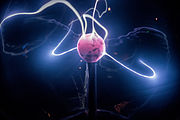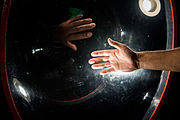Camera Obscura, Edinburgh

Camera Obscura & World of Illusions is a tourist attraction located in Outlook Tower on the Castlehill section of the
History
Short's Observatory
In the early 18th century, the Edinburgh instrument maker Thomas Short leased some land on Calton Hill to display his instruments to the public. As his lease stipulated female relatives of Thomas could not inherit the building and its contents, his wife and children did not inherit it when he died in 1788. In 1827, Maria Theresa Short returned to Edinburgh from the West Indies claiming to be Thomas Short’s daughter and attempted to claim his "Great Telescope" for her inheritance. Despite strong competition from other parties, she received the telescope and set up "Short's Popular Observatory" in 1835, housed in a wooden and stone building next to the National Monument on Calton Hill. She exhibited many scientific instruments and kept her Observatory open till 9pm each evening.[1]
After this very popular observatory was pulled down by authorities against her protests in 1851, she moved to Castlehill. In 1852, she bought the Laird of Cockpen’s townhouse, adding two storeys to create Short's Observatory, Museum of Science and Art, in existence from 1853 to 1892. The tenement is thought to be the original mansion of the Ramsays of Dalhousie (the "Lairds of Cockpen"), turned into small flats in the 18th century. The main attraction in "Short's Observatory" was the camera obscura occupying the topmost room. Her husband, Robert Henderson,[2] continued to run the attraction after Maria died in 1869.
Outlook Tower
In 1892,
The museum closed after Geddes' death in 1932. It was purchased by the University of Edinburgh in 1966 as the home for a proposed Patrick Geddes Centre and archive, but the project was greatly scaled back after the University closed its regional planning department. In 1982, the building was sold to a private owner, though a one-room Geddes exhibit remained on the fourth floor.[5]
The Tower today: Camera Obscura and World of Illusions
The tower, with its six floors of interactive exhibitions, is still open to the public, making it the oldest purpose-built attraction in the city, and one of the oldest in the United Kingdom.
- Camera Obscura in Edinburgh
-
Clip of Sparkling light effects at the Camera Obscura, Edinburgh.
Other Outlook Towers and Camera Obscuras
The concept of the Outlook Tower was tried elsewhere. When at the age of 70 Patrick Geddes moved to Montpellier, France where he bought land on a hill with a view over the city, built a house and incorporated another Outlook Tower. The house became the Scots College (Collège des Écossais). There is a working camera obscura tower (the Clifton Observatory) in Bristol, England, also others at Aberystwyth in Wales and at Kirriemuir, Dumfries and Cairngorm Mountain, Scotland.
See also
- Observatory, Bristol
- Collège des Écossais, Montpellier
References
- ^ Camera Obscura Edinburgh: "History of the Attraction" Archived 19 February 2017 at the Wayback Machine, retrieved 11 August 2015.
- ^ Maria Theresa Short married Robert Henderson, 26 April 1843, Saint Cuthbert's, Edinburgh, (Scotland, Select Marriages, 1561-1910, Ancestry Library Edition)
- ^ Early, Joyce (1991). "Sorting in Patrick Geddes' Outlook Tower". Places. 7 (3).
- ^ Hall, Peter (1988). Cities of Tomorrow. Oxford: Basil Blackwell. p. 141.
- ^ MacMillan, Duncan. "Patrick Geddes: Scotland's Renaissance man". Scottish History. Archived from the original on 17 May 2017. Retrieved 15 November 2015.
- ^ Atlas Obscura Archived 22 February 2017 at the Wayback Machine, retrieved 12 August 2015.







